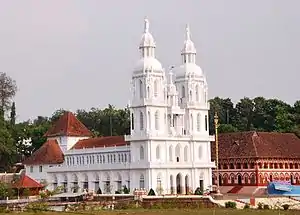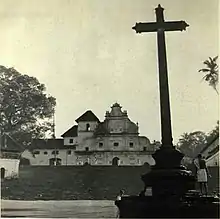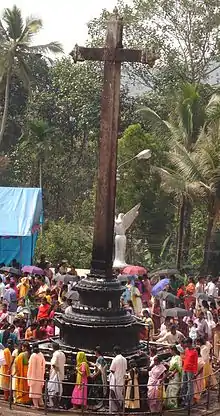Marth Mariam Syro-Malabar Church, Kuravilangad
Major Archiepiscopal Marth Mariam Archdeacon Church, Kuravilangad is a Marian pilgrim center of the Syro-Malabar Church located at Kuravilangad in Kottayam district.[1] This church claims to date to 105 AD.[2][3][4][5][6] The church has an ancient bell with the engraving on Syriac language "Mother of God." Three majestic bells were brought from Germany in 1911 and is one of the largest bells in Asia.[7] [8] [9] The church is also known for its Kappalottam or "racing ship," a commemoration of the biblical story of Jonah and the whale.[10]
| Marth Mariam Church | |
|---|---|
| Major Archiepiscopal Marth Mariam Archdeacon Pilgrim Church, Kuravilangad | |
| Kuravilangad Church | |
കുറവിലങ്ങാട് പള്ളി | |
 Major Archiepiscopal Marth Mariam Archdeacon Pilgrim Church | |
| Location | Kottayam district |
| Country | India |
| Denomination | Syro-Malabar Catholic Church |
| Tradition | Saint Thomas Christian |
| Website | http://kuravilangadpally.com/ |
| History | |
| Status | Major archiepiscopal church |
| Founded | 105 A.D |
| Dedication | Marth Mariam |
| Architecture | |
| Functional status | Active |
| Architectural type | Persian |
| Administration | |
| Archdiocese | Changanacherry |
| Diocese | Palai |
| Clergy | |
| Archbishop | Mar Joseph Perumthottam |
| Bishop(s) | Mar Joseph Kallarangatt |
| Archpriest | Rev. Dr. Kootiyani Augustine |
History

The Church of Corlengate [Kuravilangadu] was built much before the Portuguese reached India. It is in the name of the Mother of God. It was founded for the following reason. The Virgin appeared to a Christian in his sleep and ordered him to build a church at that place. But he did not obey, and she appeared to him twice more, beating him on the head with a cane. Yet he did not build the church. Soon after that one day a Christian was moved by a good spirit, and speaking in the name of Our Lady, he said that a church should be built at the said place. And they built it in the name of the Virgin Mother of God. The name of the Chris tian who built the church is not known, because he is not called by his name but he is called "the Christian of the Church."
In this church the Christians had collected much money as offerings for its edifice. Having learnt of this a kinglet of the land came by night to steal that money. He knocked at the door of the church. A priest was inside but he did not want to open it. But as they were trying to break open the door, the priest said to them that they might do whatever they wanted, but not before he died by their hands would they get away with the money of that church. Saying this he gave them a few reals through a hole in the door. They took them and went away doing no harm to the church. As they were going down from the church, one of the soldiers of the said king was bitten by a cobra and he died at once. They carried the dead man to the house of an idol. As the king and his soldiers were there with the corpse, a beam fell on the head of the king from the top of the temple. Though it did not kill him, it wounded him very badly. Hence repenting of the sacrilege, never did he dare to meddle with that church again, nor his heirs.
It is the custom in Malavar that the churches or the houses of the Christians cannot be thatched with tiles without the permission of the king of the country. However, the Christians of Quorlengate, not wanting to go along with it any more, thatched their church with tiles. Piqued by this, the king of the country went to the church and broke all its tiles. On reaching home soon after this deed, this king became mad, and discharg ing the excrement through his mouth he died miserably in a short time. His wife, who was pregnant, did not give birth even after ten months. So they opened her belly and took out the child, but she died. After that forthe fear which weighed ever more on them, they gave permission to thatch that church with tiles.
[97] One day the lord of the land closed the said church and would not allow anyone to enter it out of the hatred he had for the Christians. At that hour two big lamps remained lit in the church but with little oil. Opening that church after forty days they saw the lamps in the same condition, still burning, and the oil had not diminished at all. Seeing this, the said lord marvelled at the miracle and stopped vexing the Christians.
There was a schismatic priest [referring to Archdeacon Jacob, the East Syriac Archdeacon of Metropolitan Simon], who neither obeyed the prelate nor wanted to accept the Gregorian calendar, which this whole Christianity had accepted. He had in his party five hundred rebels of the church. He was under the illusion of the devil that he was a saint. And he corrected, I say deformed, the Liturgy of the Hours and the prayers of the Mass as he wanted. Being stupid and very proud he was going about in the habit of a Religious, which he was not. He even used to boast to be a bishop, saying that one Simon, who formerly was a bishop here but was later sacked from here, had donned him with a robe and thus made him bishop. He said also that Our Lady had appeared to him and told him not to yield. This priest stayed on at the church of Quorlengate, though he had been excommunicated by name. The other Christians could not oppose him, because in Malavar they are governed by heathen lords. However, no one went to hear his Mass, except those who were of his clique. One day a priest of the Vaypicotta seminary was confuting him with reasons. The schismatic priest maintained that Our Lady was not a virgin in partu16 and he maintained his position with stubbornness than clear reasons, while the other priest confuted him. Shortly after that, for the blasphemy he had uttered she gave him an infirmity on the tongue, which drew back little by little. In a few months he gradually lost his speech, so that no one could understand what he was saying. He died with a putrid tongue and suffering many pains, disobedient, excommunicated, and forsaken by all. For before his death all those who were of his clique had been brought back by the Fathers of the Society.
Determined to steal the money of that church, a heathen went there at midnight on three nights. But when he got within the walls, he saw many matrons reciting prayers in the church. As he saw this vision on all three nights, he became so amazed that he never again dared to return there. And he has avowed this here and there with great fear and amazement.A thief took away something of that church. But carrying it and walk ing all the night till the morning he could not go more than a quarter of a league. And the lord of the land saw him and pierced him with a spit. Many other punishments of various kinds, which God Our Lord gave to those who held little respect to that church, will be too long to narrate.[11]
Gallery
 Tomb of Palliveettil Mar Chandy, inside the Madbaha of Church.
Tomb of Palliveettil Mar Chandy, inside the Madbaha of Church. Bell at Kuravilangad with Syriac inscription
Bell at Kuravilangad with Syriac inscription Bell House at Kuravilangad Church
Bell House at Kuravilangad Church Music House at Kuravilangad Church
Music House at Kuravilangad Church Cross in front of the Church
Cross in front of the Church
References
- "Saint Mary's Forane, Kuravilangad Church". Catholics & Cultures. 11 February 2014.
- Bloomer, Kristin C. (2017). Possessed by the Virgin: Hinduism, Roman Catholicism, and Marian Possession in South India. Oxford University Press. ISBN 9780190615093.
- Nidhiry, Abraham M. (1971). Father Nidhiry, 1842-1904: A History of His Times. George John Nidhiry; distributors: Deepika Book House, Kottayam.
- Mathew, Biju (2016). Kerala Tradition & Fascinating Destinations 2016. Info Kerala Communications Pvt Ltd. ISBN 9788192947051.
- "St. Mary's Church Kuravilangad - Must Visit Church in Kerala | Kerala Tourism". www.tourmyindia.com.
- "St. Mary's Church, Kuravilangad, Kottayam, Kerala | Kerala Tourism". www.keralatourism.org.
- Staff Reporter (23 January 2013). "Commemorating a voyage of faith". The Hindu.
- "Special status conferred on "world's first" Marian shrine". Matters India. 22 January 2018.
- "Asia's largest Church Bell - Picture of St. Mary's Forane Church, Kuravilangad - TripAdvisor". www.tripadvisor.in.
- Sherwood, Yvonne (2000). A Biblical Text and Its Afterlives: The Survival of Jonah in Western Culture. Cambridge University Press. ISBN 9780521795616.
- History Document about Kuravilangad church(Sarah Knight)
Bibliography
- Nedungatt, George (2001). The Synod of Diamper Revisited. Pontificio Istituto Orientale. ISBN 9788872103319.
